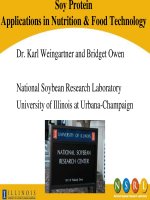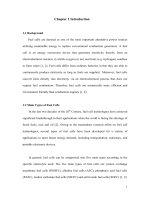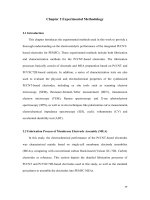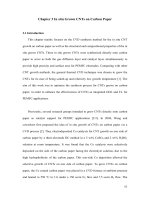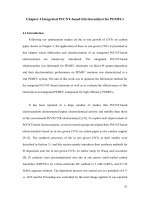Protein separation in ion exchange membrane partitioned free flow isoelectric focusing (IEM FFIEF) system
Bạn đang xem bản rút gọn của tài liệu. Xem và tải ngay bản đầy đủ của tài liệu tại đây (8.5 MB, 210 trang )
PROTEIN SEPARATION IN ION-EXCHANGE
MEMBRANE PARTITIONED FREE-FLOW ISOELECTRIC
FOCUSING (IEM-FFIEF) SYSTEM
CHENG JIUHUA
Bachelor Degree of Technology (Hons)
National University of Singapore
A Thesis Submitted for the Degree of Doctor of Philosophy
Department of Chemical & Biomolecular Engineering
National University of Singapore
2010.04.
i
Acknowledgements
I am first of all deeply obliged to my supervisor, Professor N. T S. Chung. His insightful
outlook has guided me into a broad scope of membrane science, and over the course of my
studies he has taught me the academic research from the very basics. He has also helped me
in my further development through his endless enthusiasm in educating me, and has given
me every possible resource and facilities to develop the IEM-FFIEF technology. His trust has
encouraged me to endure the most arduous times in my research career here. His everlasting
mentorship supports me from the beginning to the end: time never stops, but yet his teaching
quality never decreases. Moreover, his dedication to science has spurred me to pursue the
truth as a real scientist.
I would like to express my appreciation to Prof. S. B. Chen and Prof. B. Liu due to their
constructive suggestions on my Ph.D proposal. As an expert in the field of electrophoresis,
Prof. Chen has provided a few critical and necessary questions for me to understand the
electrophoresis phenomenon, which has been very helpful throughout my Ph.D candidature
in NUS.
I would also express my thanks to all the team members in Prof. Chung’s research group.
Especially thanks are especially conveyed to Dr. Y. C. Xiao and Dr. Y. Li for their guidance
in the early stages of my research. Special thanks are also conveyed to Ms. B. T. Low and Dr.
ii
M. M. Teoh, for their noble deeds and patience in helping me through academic life. The
advice that I have obtained from Dr. Q. Yang and Dr. K. Y. Wang are all also very valuable.
The countless suggestions and help from all my colleagues in Prof. Chung’s group made my
research life in NUS full of tears and smiles. These colleagues are: Dr. Y. C. Xiao, Ms. B. T.
Low, Dr. M. M. Teoh, Ms. W. Natalia, Y. Wang, N. Peng and Z. Z. Zhou.
My thanks also go out to A-star and the National University of Singapore (NUS) for funding
this research with the grant numbers of R-279-000-164-305 and R-279-000-249-646.
Last but not least, I am deeply indebted to my husband, Xuehua Liu, for his steadfast support,
self-sacrificial attitude as well as his love shown to our family. Special thanks also go to my
two daughters, for their toughness and endurance in life, for their growing together with my
research. They are Hong Zhan Liu (12 years old), Hong Zhi Liu (4 years old).
Jiu-Hua Cheng
iii
Table of Contents
Acknowledgement ……………………………………………………………………… i
Table of contents ……………………………………………………………………… iii
Summary………………………………………………………………………………….x
Nomenclature………………………………………………………………………… xiv
List of Tables…………………………………………………………………………….xix
List of Figures………………………………………………………………………… xx
CHAPTER 1 INTRODUCTION…………………………………………………………… 1
1.1. Membrane based protein separation and its history…………………………………1
1.1.1. Scientific Milestones………………………………………………………….4
1.1.1.1. Pressure driven ultrafiltration…………………………………………5
1.1.1.2. Electric field driven electrophoresis………………………………… 8
1.2. Development of boundary effect theory…………………………………………….13
1.2.1. Hindered mass transfer……………………………………………………….13
1.2.2. Thin double layer and protein separation…………………………………….15
1.2.3. Thick double layer and protein separation……………………………………17
1.3. Membrane technologies for protein separation………………………………………19
1.3.1. Membrane materials……………………………………………………… 20
1.3.1.1. Nature material…………………………………………………………21
1.3.1.2. Organic (polymer) materials and their modifications…………… 21
iv
1.3.1.3. Inorganic material…………………………………………………….24
1.3.2. Membrane fabrication……………………………………………………… 25
1.3.3. Membrane modules design and system design……………………………….29
1.3.3.1. The plate-and -frame module……………………………………… 30
1.3.3.2. The spiral wound module…………………………………………….30
1.3.3.3. The hollow fiber module…………………………………………… 31
1.4. Research objectives…………………………………………………………………32
1.5. Organization of this research……………………………………………………….34
1.6. Reference ………………………………………………………………………… 35
CHAPTER 2 MATERIALS AND EXPERIMENTAL PROCEDURE…………………… 40
2.1. Materials……………………………………………………………………………… 40
2.1.1. Polymers…………………………………………………………………………40
2.1.2. Polymer modification……………………………………………………………41
2.1.3. Proteins used as separation model………………………………………………42
2.1.4. Other materials………………………………………………………………… 43
2.2. Membrane fabrication………………………………………………………………….44
2.3. Membrane Characterization and Evaluation………………………………………… 46
2.3.1. FTIR……………………………………………………………………………46
2.3.2. XPS…………………………………………………………………………….47
2.3.3. SEM or FESEM and EDX…………………………………………………….47
2.3.4. Surface zeta potential…………………………………………………………48
2.3.5. Ion-exchange capacity…………………………………………………………51
v
2.3.6. Pore size distribution……………………………………………………………51
2.4. Protein Analysis Methods……………………………………………………………….52
2.4.1. HPLC …………………………………………………………………………….52
2.4.2. Kinetic function of UV-Vis spectroscopy……………………………………… 53
2.4.3. Capillary Electrophoresis……………………………………………………… 54
2.5. Reference………………………………………………………………………………54
CHAPTER 3 HIGH-PERFORMANCE PROTEIN SEPARATION BY ION EXCHANGE
MEMBRANE PARTITIONED FREE-FLOWISOELECTRIC FOCUSING
SYSTEM……………………………………………………………………56
3.1. Introduction ………………………………………………………………………… 56
3.2. Working principle of the IEM-FFIEF system…………………………………………59
3.3. Experimental ………………………………………………………………………….61
3.3.1. Materials ……………………………………………………………………….61
3.3.2. Sulfonation procedure of polysulfone………………………………………….62
3.3.3. Membrane fabrication………………………………………………………….62
3.3.4. Characterizations………………………………………………………………63
3.3.5. The protein analysis method………………………………………………… 64
3.3.6. Protein separation experiments in the FFIEF system………………………….65
3.4. Results and discussion……………………………………………………………… 69
3.4.1. Characterizations of polymer materials and membranes…………………… 69
3.4.2 Protein separation performance under the batch operation……………………73
3.4.3 Protein separation performance under the semi-batch operation…………… 76
vi
3.5. Conclusions……………………………………………………………………………80
3.6. References…………………………………………………………………………….82
CHAPTER 4 INVESTIGATION OF MASS TRANSFER IN THE ION-EXCHANGE
MEMBRANE PARTITIONED FREE-FLOW ISOELECTRIC FOCUSING
SYSTEM (IEM-FFIEF) FOR PROTEIN SEPARATION……………………86
4.1. Introduction…………………………………………………………………………… 86
4.2. Theoretical background……………………………………………………………… 89
4.2.1. Isoelectric focusing for protein separation………………………………………89
4.2.2. Boundary effects of the membrane…………………………………………… 91
4.2.3. Minimal electric field strength E
0
for flux breakthrough……………………….92
4.2.4. Undisturbed electric field strength E
∞
and disturbed electric field strength E
∞
′
……………………………………………………………………………………94
4.2.5. Surface ζ-potentials for a thick-double layer…………………………………95
4.3. Experimental…………………………………………………………………………97
4.3.1. Materials………………………………………………………………………97
4.3.2. Membrane fabrication ……………………………………………………….97
4.3.2.1. Measurement of the electrical properties of membranes ……………98
4.3.2.2. Pore size distribution and porosity measurements ………………….98
4.3.2.3. Verification of the trans-membrane pH gradient ……………………99
4.3.2.4. Protein separation ……………………………………………………100
4.3.3. Analysis of proteins ………………………………………………………….100
4.4. Results and discussions…………………………………………………………… 101
vii
4.4.1. Confirmations of sulfonation and verification of pH gradient across the membrane
……………………………………………………………………………101
4.4.2. Micro-structure characterizations of membranes………………………………103
4.4.3. Physical properties of protein molecules ………………………………………103
4.4.4. Electrical properties of membranes ……………………………………………104
4.4.5. Comparison of theoretical and experimental velocities ……………………….109
4.4.6. Protein separation experiments ……………………………………………… 114
4.5. Conclusions ……………………………………………………………………………115
4.6. References …………………………………………………………………………… 116
4.7. Appendix ………………………………………………………………………………120
CHAPTER 5 SELF-SHARPENING PHENOMENON ARISEN BY ION-EXCHANGE
MEMBRANES IN MULTI-COMPARTMENT FREE-FLOW ISOELECTRIC
FOCUSING (IEM-FFIEF) …………………………………………………121
5.1. Introduction……………………………………………………………………………121
5.2. Experimental ………………………………………………………………………… 124
5.2.1. Materials………………………………………………………………………124
5.2.2. Preparation of membranes ……………………………………………………125
5.2.3. Polymer and membrane characterizations ……………………………………127
5.2.4. Protein separation by APPO membrane partitioned FFIEF ………………….129
5.3. Results and discussions ………………………………………………………………131
5.3.1. Confirmation of the polymer modification ……………………………………131
5.3.2. Characterizations of membrane electric properties ……………………………134
viii
5.3.3. Morphology and pore size distributions ………………………………………136
5.3.4. Protein separation through an IEM-FFIEF ……………………………………138
5.5. Conclusions ………………………………………………………………………….144
5.6. References ……………………………………………………………………………145
CHAPTER 6 CHEMICAL MODIFICATION OF P84 POLYIMIDE AS ANION-
EXCHANGE MEMBRANES IN A FREE-FLOW ISOELECTRIC
FOCUSING SYSTEM FOR PROTEIN SEPARATION……………………148
6.1. Introduction ……………………………………………………………………………148
6.2. Experimental …………………………………………………………………………150
6.2.1. Experimental set-up ……………………………………………………………150
6.2.2. Materials ……………………………………………………………………….152
6.2.3. Preparation of P84 anion exchange flat membranes ………………………… 153
6.2.4. Membrane characterization …………………………………………………….154
6.2.5. HPLC analyses of protein solution …………………………………………… 157
6.2.6. Protein separation by anion exchange membrane partitioned free flow isoelectric
focusing (IEM-FFIEF) ………………………………………………………… 158
6.3. Results and discussion ………………………………………………………………159
6.3.1. Confirmation of the modification …………………………………………… 159
6.3.2. Pure water permeation (PWP) and morphological changes during
modifications….…………………….………………………………………165
6.3.3. Protein separation performance ……………………………………………….170
6.4. Conclusion ………………………………………………………………………….173
ix
6.5. Reference …………………………………………………………………………….174
CHAPTER 7 CONCLUSIONS AND RECOMMENDATIONS ………………………….178
7.1. The conclusions drawn from this dissertation ………………………………………178
7.1.1. The feasibility of IEM-FFIEF ……………………………………………… 178
7.1.2. Mass transfer in IEM-FFIEF …………………………………………………179
7.1.3. Self-sharpening phenomenon in IEM-FFIEF system ……………………… 179
7.1.4. Amination of P84 membrane surface …………………………………………180
7.2. Recommendations for future work …………………………………………………181
7.2.1. Process optimizations ……………………………………………………… 181
7.2.2. Other potential applications ………………………………………………….182
7.2.3. Membrane fabrication technologies …………………………………………183
Publications………………………………………………………………………………184
Appendix………………………………………………………………………… 185
x
Summary
Ion Exchange Membrane Partitioned Free-Flow Isoelectric Focusing (IEM-FFIEF) is an
emerging separation process combining both membrane technologies and electrophoresis
technologies in a series of separated chambers. Driven by electric field, IEM-FFIEF allows
charged species freely migrate in bulk solutions, selectively cross the membranes and
predeterminedly be concentrated in a certain chamber. Hence, IEM-FFIEF is practically
effective and economically feasible for the separation of protein mixtures as well as other
bio-products from plasma or fermentation broth. The purpose of this work is to explore the
feasibility of IEM-FFIEF, to fabricate high performance protein separation ion exchange
membranes, and to investigate the effects of various factors on separation performance.
Emphases are placed on the understanding of mass transfer across the separation membrane
under an environment of isoelectric focusing.
This study firstly investigated the feasibility of a combination of membrane technology and
the Free-Flow Isoelectric Focusing (FFIEF) technology for a high-performance protein
separation, in which ion exchange membranes are used as the separation media. A FFIEF
device has been designed and extensive experiments have been conducted to prove its
efficacy in enhancing the protein separation performance. Three types of membranes were
employed in this work to replace conventional immobiline membranes. They were
commercial microfiltration (MF) ion exchange membranes, commercial neutral ultrafiltration
(UF) cellulose membranes, and home-made ultrafiltration sulfonated polysulfone (UF SPSf)
ion exchange membranes. The protein separation results show that the home-made UF SPSf
xi
membranes have the superior selectivity and flux to other membranes. This is due to the fact
that a stable pH gradient across the membranes as well as the interaction between the protein
molecules and membrane surface play an important role in the high-performance protein
separation. By applying a semi-batch separation process and optimizing various experimental
conditions, a high-purity (> 90 %) and concentrated target protein is obtained at the
permeation side of the home-made UF SPSf membranes with a high flux. This work clearly
demonstrates the great potential of FFIEF for industrial applications. Moreover, experimental
results in the consecutive semi-batch operations suggests that the membrane fouling
phenomenon is not severe, and high reproducibility in separation fluxes can be realized in
our designed IEM-FFIEF system.
Secondly, this study was then extended to the investigation of protein mass transfer in IEM-
FFIEF system. A series polysulfone based cation-exchange membranes with strong
mechanical strength have been developed and applied in free-flow isoelectric focusing (IEM-
FFIEF). A fundamental understanding of protein mass transfer in the IEM-FFIEF process has
been revealed experimentally, with the aid of boundary effect model contributed by Ennis,
Zhang, Steven, Perera and Carnie. We have proven experimentally the existence of a pH
gradient across the membrane cross-section when the IEM-FFIEF system is in operation. The
boundary effects on particle velocities are calculated based on the IEF assumption and
various characterizations, and are compared with the experimental results. In the IEM-FFIEF
experiments, a protein mixture (bovine serum albumin (BSA) and myoglobin (Mb)) and
sulfonated polysulfone membranes with different ion-exchange capacities (IEC) are applied.
Experimental results show that the real velocity and real mobility (of Mb in this study) are
xii
comparable with the mathematic model developed by Ennis et al. These results suggest that
the equation proposed by Ennis et al. is sufficient to capture the mass transfer through
membrane in the IEM-FFIEF system after considering the effects of pore size distribution
and effects of disturbed electric field. The charge properties of the membrane surface play a
dominant role on the separation performance of the membranes. Replacing gel-like
immobilines, the newly developed porous ion-exchange membranes may effectively perform
the selective function for protein separation.
Thirdly, a very unique phenomenon - self-sharpening arisen by ion-exchange membranes is
studied in this research work. In order to reduce the overlapping components in a single
chamber, aminated poly(2, 6-dimethyl-1, 4-phenylene oxide) (APPO) based anion-exchange
membranes are applied in free-flow isoelectric focusing (FFIEF) instead of conventional
immobiline membranes as the selective mass transfer media. The APPO polymers with
different amination rates are blended with polysulfone and cast on non-woven fabric by the
phase inversion technology. Characterizations of XPS scanning, streaming potential and ion-
exchange capacity (IEC) demonstrate that the self-prepared membranes posses different
extent of amination and IEC values. The performances of the three prepared APPO
membranes with different IEC values are compared. Instead of pH imbedded gel-like
immobiline membranes, nine pieces of identical porous APPO membranes are employed in
FFIEF. The protein mixture comprising bovine serum albumin (BSA), myoglobin (Mb) and
lysozyme (Lys) is used as feed solution. Experimental results show that membranes with a
higher charge density not only can affect a higher mass transfer rate, but also strengthens the
“self-sharpening” function greatly. Therefore, highly charged porous membranes are
xiii
favorable in reducing the amount of overlapping components in individual chambers for
multi-component protein separations.
Fourthly, by means of amination with diamine and methylation with methyl iodide, we have
modified P84 microporous polyimide membranes with characteristics of highly charged
anion-exchange membranes. FTIR and XPS scans confirm the amination and methylation
reactions on membrane surface. The intrinsic properties of the newly developed anion-
exchange membranes have been fully characterized in terms of ζ-potentials, electrical
resistances, PWP (pure water permeation) and pore size distributions. By using the newly
developed membranes, a free-flow isoelectric focusing (IEM-FFIEF) has been set up for the
separation of myoglobin (Mb) and lysozyme (Lys) mixtures. Experimental data show that (1)
the Mb flux via the highly charged P84 anion-exchange membrane can be 10 times higher
than that of the original P84 membrane and (2) the high surface charge is the predominant
factor for the enhanced Mb flux. HPLC results show that not only the Mb flux was high, but
its purity in the permeate side is also extremely high. It is therefore concluded that the
diamine and methyl iodide modifications can effectively modulate P84 nano-porous
membranes with anion-exchange characteristics, which is suitable for the IEM-FFIEF
application.
xiv
Nomenclatures:
a
Radius of protein solute, in nm.
A
Effective cross-section area of membrane, in m
2
.
b
Radius of pore, in nm.
C
bi
Concentration of ions dissociated from buffer solution, in mole.L
-1
.
C
i
f
Concentration of ionic species i in feed chamber, in mole.L
-1
.
C
im
Concentration of ionic species i in membrane, in mole.L
-1
.
C
im
f
Concentration of ionic species i at the feed side of membrane, in mole.L
-1
.
C
i0
f
The original concentration of ionic species i in feed chamber, in mole.L
-1
.
C
0
Concentration of ionic species i at z
i
= 0 (x=0) inside membrane, in
mole.L
-1
.
D
im
The diffusivity of ionic species i in membrane, in m
2
.S
-1
.
d
p
Nominal pore diameter of membrane, in nm.
E
Electric field strength E = ι/(κ
0
A) , in V.m
-1
.
E
∞
Undisturbed electric field density, in V.m
-1
.
E
∞
′
Disturbed electric field density, in V.m
-1
.
e
z
Unit vector in electric field direction.
F
Faraday constant, F = N
A
*e = 96485 C.mole
-1
.
F
p
The percentage of pores above minimal effective pore size d
p
=7.8nm.
I
Ionic strength, in mole.L
-1
.
I
o
The zero order term of the first kind of modified Bessel functions.
I
1
The first order term of the first kind of modified Bessel functions.
xv
IEC Ion exchange capacity, in meq.m
-2
.
i
Ionic species i of protein molecules, i = 1, 2.
L
Effective thickness of membrane, in
μ
m.
l
Total length between two electrodes, in cm.
m
1
Mass of membrane before drying up for porosity measurement, in gram.
m
2
Mass of membrane after drying up for porosity measurement, in gram.
N
i
Total number of amino acid units in a protein molecule.
n
i
z
Charge number on one protein molecule.
ΔP
Pressure drop tested by surface analyzer, in kPa.
p
An electrophoresis constant defined by Svensson, μ
im
= - px.
q
s
Surface charge quantity, in Coulomb.
R
Ideal gas constant, 8.314 J.mol
-1
.K
-1
.
R
e
Minimal effective pore radius, in nm.
R
T
The retention also is referred as rejection rate.
T
Temperature in Kelvin.
V
Constant voltage applied on electrophoresis, in volt.
V
f
Volume of feed chamber, in m
3
.
ι
Current of electrophoresis, in A.
μ Mobility, in m
2
.V
-1
.s
-1
.
μ
im
Mobility of ionic species i in membrane, in m
2
.V
-1
.s
-1
.
μ
s
Mobility of solute particles in m
2
.V
-1
.s
-1
z
bi
Valence of ion i dissociated from the buffer solutes, here z
bi
=1.
z
i
Effective valence for species i.
xvi
z
p
Valence of every charge site for protein molecules, here z
p
= 1.
x
Coordinate along the direction of membrane thickness. x = 0 at pH=6.8
side.
ζ
s
ζ
-potential of protein molecule surface, in mV.
ζ
w
f
ζ
-potential of membrane pore surface at feed side, in mV.
ζ
s
f
ζ
-potential of protein molecule surface at feed side, in mV.
ζ
t
Interaction potential between membrane and protein molecules, in mV.
γ
γ
=
ζ
w
/
ζ
s
, the ratio between the
ζ
-potential of pore wall and the
ζ
-potential
of solute particle.
κ
-1
Debye’s length, in nm.
κ
a
The dimensionless size of protein molecules.
κ
b
The dimensionless size of pore.
κ
0
The conductivity of buffer solution in the feed chamber, in mS.m
-1
.
κ
w
The overall conductivity given by κ
w
= ι / Vl.
λ
The ratio between protein molecule size and pore size.
λ = a / b < 1 is the ratio of particle size and pore size
ε
Dielectric constant.
ε
p
Membrane porosity.
ε
r
The relative permittivity.
ε
0
The dielectric permittivity of a vacuum. ε
0
= 8.85x10‾
12
C
2
. J
-1
.m
-1
.
η
Viscosity of solution, in mPa.sec
ρ
w
Density of water, in g.cm
-3
.
xvii
ρ
p
Density of polymer, in g.cm
-3
.
υ
Translation velocity, in m.sec
-1
.
υ
real
The real velocity measured by experiment, in m.sec
-1
.
AHA Dense anion-exchange membrane.
APPO Aminated poly(2,6-dimethyl-1,4-phenylene oxide).
BPPO Brominated poly(2,6-dimethyl-1,4-phenylene oxide).
BSA Bovine serum albumin.
ACN Acetonitrile.
CEM Dense cation-exchange membrane.
FESEM Field emission scanning electron microscopy.
FFE Free-flow electrophoresis, (Becton-Dickinson Inc., USA).
FFIEF Free-flow isoelectric focusing.
FTIR-ATR Fourier transform infrared- attenuated total reflectance.
GR Guaranteed reagent.
HPLC High performance liquid chromatography.
IEC Ion-exchange capacity.
IPA Isopropanol.
Lys Lysozyme.
Mb
NMP
Myoglobin.
N-methyl-2-pyrrolidone.
pI Isoelectric points.
xviii
PEO Polyethylene oxide
PEG Polyethylene glycol
PPO Poly(2,6-dimethyl-1,4-phenylene oxide) polymer.
PSf Polysulfone polymer.
PVP Polyvinylpyrrolidone
PWP Pure water permeation.
TEA Triethylamine.
THF Tetrahydrofurane.
XPS X-ray photoelectron spectroscopy.
xix
List of Tables
Table 1-1 Separation of egg albumin and hemoglobin by electrical transport
Table 2-1 Chemical structure and properties of applied polymer
Table 2-2 HPLC running conditions
Table 3-1 Ion exchange capacity results of SPSf materials and various membranes
Table 3-2 HPLC test results for the protein concentration
Table 4-1 Membrane characterization
Table 4-2 Protein molecule sizes and charge numbers
Table 4-3 The calculation of undisturbed electric field E
∞
and disturbed electric field E
∞
’
Table 4-4 Comparison of the velocities from experiment and from theoretical prediction
Table 4-5 Comparison of the relative velocities
Table 5-1 Comparison of XPS results of membrane surface with different extents of
Modification
Table 5-2 Ion exchange capacity of the membranes with different modification rates
Table 5-3 Pore size characterization and pure water permeation (PWP)
Table 6-1 Running conditions of HPLC
Table 6-2 The XPS element analyses of the original P84 membrane and methylated
amine membranes
Table 6-3 Membrane characterization data and protein separation fluxes of different
types of membranes
Table 6-4 Mechanical strength and stability of membrane M-3
xx
List of Figures
Fig. 1-1 The membrane-based protein separation apparatus suggested by Kirkwood (1941)
Fig. 1-2 The simplest multi-membrane electrodecantation apparatus of Polson
Fig. 1-3 The modified electrodecantation apparatus of Polson
Fig. 1-4 The free flow focusing apparatus RF3 and its cross-section view
Fig. 1-5 Comparison between electrophoretic mobility and Stokes’ mobility of a sphere on
the axis of infinitely long pores
Fig. 1-6 Typical membrane structures
Fig. 1-7 Electrolysis of sodium chloride solution
Fig. 1-8 Electrodialysis of waste water
Fig. 1-9 Spiral-wound module and its assembly
Fig. 1-10 The hollow fiber module of membrane based hemodialyzer
Fig. 2-1 The electrochemical double layer and measured surface zeta-potential
Fig. 3-1 Theoretical schematic of the IEM-FFIEF method
Fig. 3-2 Experiment set up
Fig. 3-3 Schematic diagram of the electrophoresis device
Fig. 3-4 FTIR spectra of polysulfone (PSf) and sulfonated polysulfone (SPSf)
Fig. 3-5 SEM images of self-made membrane A, B, C
Fig. 3-6 Real rejection curves, plotted on the log-normal probability ordinate system
Fig. 3-7 Probability density function curves of self-made membranes A, B and C
Fig. 3-8 Cumulative pore size distributions of self-made membranes A, B and C
Fig. 3-9 Comparison of protein separation performances of different membranes under 200V
and the batch operation
xxi
Fig. 3-10 Effect of different voltages on the protein separation performances of membranes
under the batch operation
Fig. 3-11 Semi-batch performance tests under 200V
Fig. 3-12 The current flowing through the system at given voltage V=200V
Fig. 3-13 Current tendency vs. applied voltage
Fig. 3-14 Results of stability and reproducibility measurement of membranes A and C under
200V and the semi-batch operation
Fig. 4-1 Experimental set up
Fig. 4-2 Schematic of the IEM-FFIEF device
Fig. 4-3 Illustration of mass transfer in the ion exchanged membrane of FFIEF
Fig. 4-4 FTIR spectra of polysulfone (PSf) and sulfonated polysulfone (SPSf)
Fig. 4-5 pH gradient profiles across membrane cross-sections
Fig. 4-6 Pore size distribution and effective pore size
Fig. 4-7 ζ-potentials as a function of pH
Fig. 4-8 Relative mobility of proteins as a function of λ calculated from the Ennis’s theory
for κa=1
Fig. 4-9 dC/dt monitored by UV-Vis spectrometer kinetic function
Fig. 4-10 Comparison of mobilities from experiments and theoretical predictions
Fig. 4-11 Comparison of velocities from experiments and theoretical predictions
Fig. 4-12 The HPLC results of protein separation
Fig. 5-1 The modification of brominated poly(2,6-dimethyl-1,4-phenylene oxide) (BPPO)
Fig. 5-2 Experimental set-up
Fig. 5-3 The design of the IEM-FFIEF cell
Fig. 5-4 FTIR scanning of PPO, BPPO and APPO
xxii
Fig. 5-5 XPS curve fitting of C 1s core-level on membrane surfaces with different amination
rates
Fig. 5-6 XPS curve fitting of N 1s core-level on membrane surfaces with different amination
rates
Fig. 5-7 Membranes’ streaming potentials with different modification rates
Fig. 5-8 The SEM image of membranes’ surfaces and cross-sections
Fig. 5-9 Pore Size distributions of M- A, B and C measured by a porometer
Fig. 5-10 The comparison of mass transfer rates through the slopes of concentration vs. time
Fig. 5-11 HPLC results of 3-component protein separation in IEM- FFIEF
Fig. 6-1 Experimental set up of the IEM-FFIEF system
Fig. 6-2 Close-up of the membrane partitioned isoelectric focusing cell
Fig. 6-3 Chemical structure and reactions of P84
Fig. 6-4 FTIR-ATR spectra of the original P84 membrane M-O, diamine modified membrane
M-1, methylated amine membrane M-2 and M-3
Fig. 6-5 Comparison of element ratio from wide scans of the original P84 membrane
(M-O) and quaternary amine membrane (M-3)
Fig. 6-6 XPS analysis of 1s C of the original P84 membrane M-O, diamine modified
membrane M-1 and quaternary amine membrane M-3 membranes
Fig. 6-7 XPS analysis of 1s N of the original P84 membrane M-O and quaternary amine
membrane M-3
Fig. 6-8 ζ-potentials of four types of membranes from different modification steps
Fig. 6-9 Real rejection rates of four types of membranes
Fig. 6-10 Probability density functions of pore size distributions
Fig. 6-11 Cumulative pore size distributions
Fig. 6-12 Comparison of FESEM images of four types of membranes from different
modification steps: M-O, M-1, M-2 and M-3.
xxiii
Fig. 6-13 Protein separation fluxes monitored by a UV-vis spectrometer
Fig. 6-14 HPLC results of protein separation of (Mb+Lys) in the IEM-FFIEF system
1
CHAPTER 1 INTRODUCTION
Proteins are the basic, essential and vast distributed material of all form of life on earth;
they are vital for organisms and are involve in almost every cellular process. Proteins are
the most complicated natural resources which have been recognized as a food
commodity since the early days of humans on this planet, and it has only been
determined recently that different proteins possess specific biological functions within
living organisms. The understanding of protein functions can thus aid scientists in the
determination of disease mechanisms; hence leading drug development to aim for
reductions in side-effects [
1
]. Therefore, drug proteins have gained great attention in the
market nowadays. Statistics show that drug companies sold nearly $ 33 billion in protein
drugs in 2002; rising at an average annual growth rate (AAGR) of 12.2 %, this market
was supposed to reach $ 71 billion in 2008 [
2
]. Among all these protein products,
monoclonal antibodies were recognized as having the most potential in the development of
therapeutic protein products. Since the first monoclonal antibody was licensed for sale in
1986, 21 antibody products have been licensed and put on the market, causing the antibody
market worth to expand to $ 21.9 bn in 2008 [
3
,
4
]. Besides protein drugs, there is a great
demand for many other types of protein products for various applications like that of
bioengineering tissue and organ engineering, as well as for new R & D initiatives. In
addition, peptides and their derivatives are also considered as other important sources of
therapeutic drugs. Hence, it is believed that the real market (except for food) for purified
protein products is much larger than the above statistics of protein drugs.
1.1 Membrane based protein separation and its history
